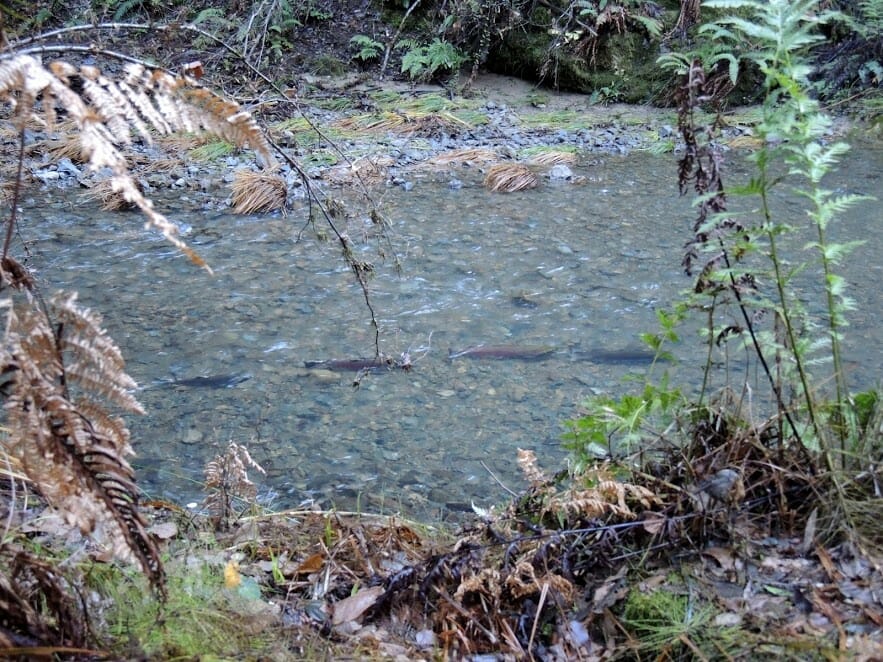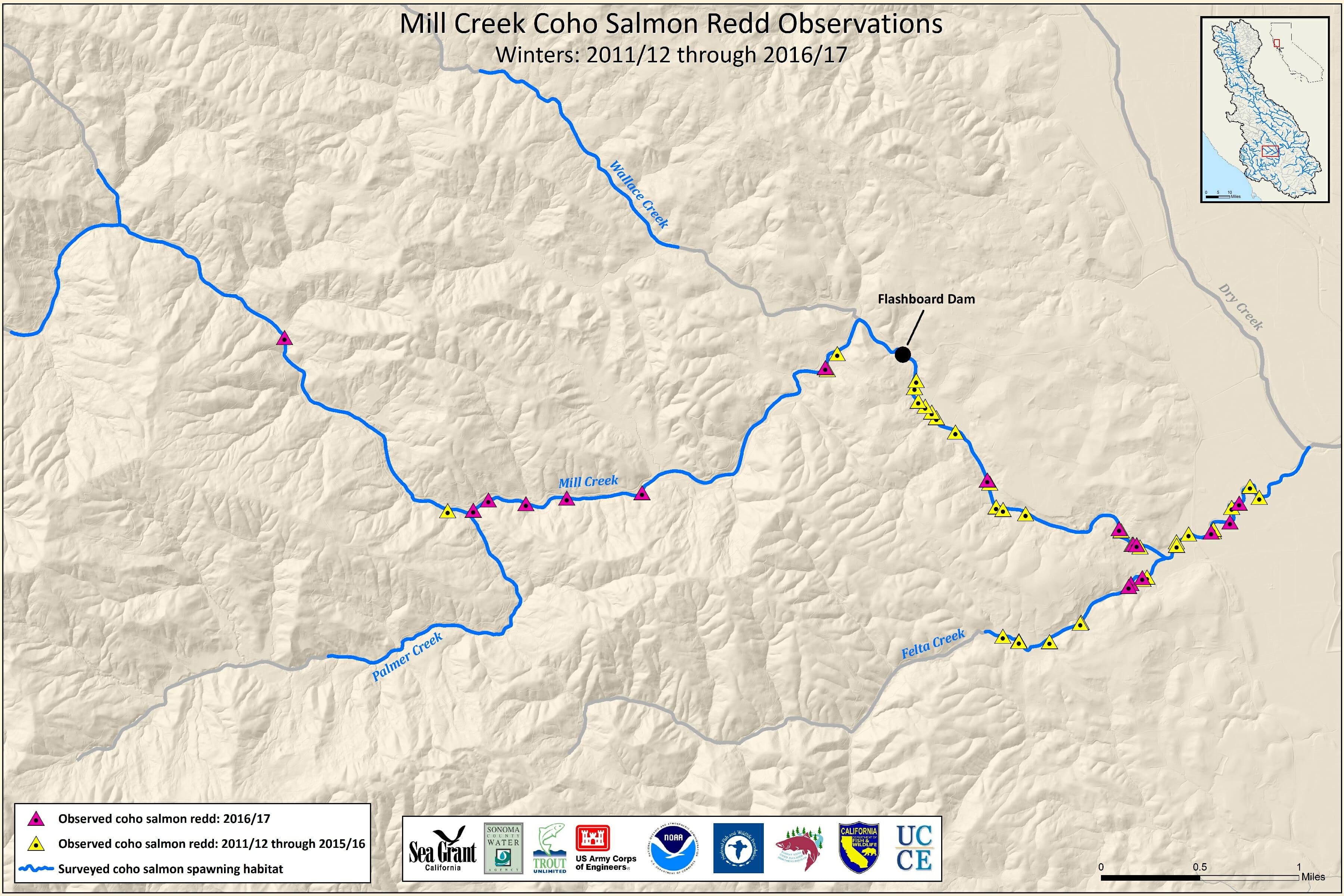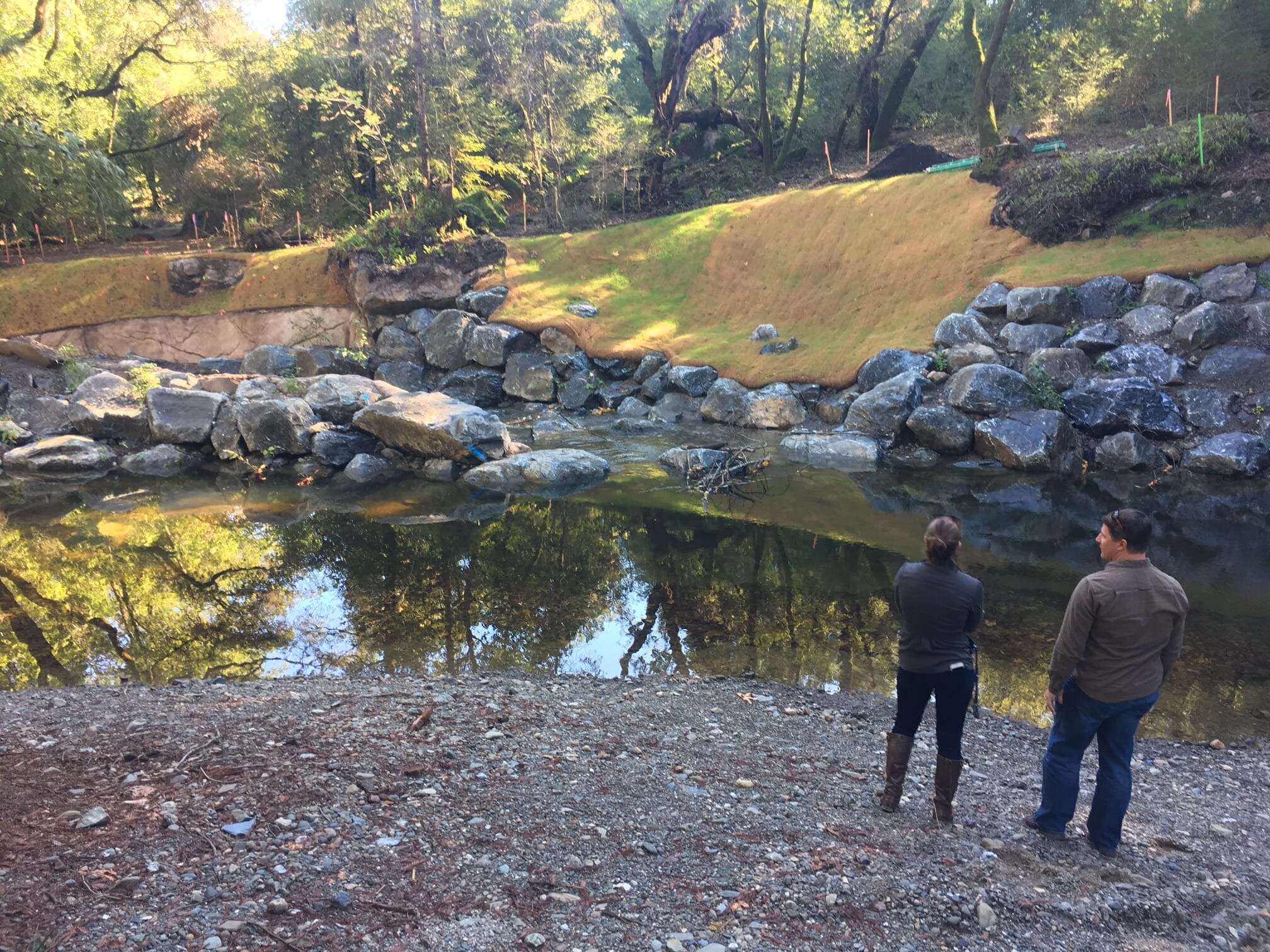The Mill Creek Dam Fish Passage Project site, post-construction and just prior to this winter’s heavy rains. The roughened main channel and side channel will make it easier for coho and steelhead to migrate past the site.
As record-breaking rains pounded northern California over the past three months, emphatically ending five years of extreme drought for most of the state, a major TU-driven fish passage project in a key tributary to the Russian River began paying dividends almost immediately.
The Mill Creek Dam Fish Passage Project dramatically improves access for coho salmon and steelhead to more than eleven miles of high quality spawning and rearing habitat. TU and a variety of partners completed construction on this project last October.
 alt=”” title=”” />(R) Coho salmon in Mill Creek above the fish passage project site. Photo: Mary Ann King
alt=”” title=”” />(R) Coho salmon in Mill Creek above the fish passage project site. Photo: Mary Ann King
Shortly after Mill Creek connected to Dry Creek, and then to the Russian River, in November, coho salmon began showing up. By February 2017, more than eight redds (nests) had been documented upstream of the project site. The Santa Rosa Press Democrat covered this news in this recent feature article.
Adult coho salmons returns in the Russian River system, at one time probably 100,000 fish, have fallen to as few as five fish in recent years. State and federal fisheries management agencies have made it a top priority to restore habitat and improve fish passage throughout the Russian River system. Trout Unlimited is a key partner in this effort.
The Mill Creek project took three years to complete but almost never got off the ground, due to logistical challenges and the complexities of working on and around private properties.
“People will always have questions and concerns about a major restoration project in their back yard,” said Mary Ann King, director of TU’s Coastal Streamflow Stewardship Project and the Mill Creek project manager. “But almost everyone likes the idea of a healthy stream nearby, with salmon in it. In the end the residents of Mill Creek made the difference.”
“We take pride as a family in knowing that people like my father, Daniel, who has a very deep and profound love of nature—especially the life cycle of steelhead and salmon—made this project possible,” said Paul Golling. The Gollings graciously allowed their property to be used as the access point for construction equipment during the project.
 alt=”” title=”” />(L) Remnants of the old flashboard dam, Mill Creek fish passage project.
alt=”” title=”” />(L) Remnants of the old flashboard dam, Mill Creek fish passage project.
Fish access to the upper reaches of Mill Creek has been impeded for decades by a flashboard dam. The dam was a complete barrier to upstream passage for juvenile Coho and steelhead and a partial barrier to upstream adult passage, under almost all flow conditions. Through construction of a roughened ramp and side channel, the project eliminates this barrier and restores fish access to 11.2 miles of high quality habitat.
This landmark project was completed by TU and Prunuske Chatham, Inc. (PCI). Funding was provided by the NOAA Restoration Center’s Community-based Habitat Restoration Program, the California Department of Fish and Wildlife’s Fisheries Restoration Grant Program, and the Sonoma County Water Agency. UC Cooperative Extension and California Sea Grant is conducting pre- and post-project monitoring.
Mill Creek is a Core Area in the National Marine Fisheries Service’s Recovery Plan (2012) for California coho salmon and a priority for the Russian River Coho Salmon Conservation Program. Consistently, a significant percentage of juvenile and adult coho documented in Russian River streams are found in Mill Creek. The project is especially valuable because the portion of Mill Creek above the project site remains wet year-round. Many tributaries to rivers in this region —including Mill Creek below the dam—become disconnected or dewatered in the summer and fall.
 alt=”” title=”” />(R) Map of coho salmon redds, Mill Creek. Image by California Sea Grant.
alt=”” title=”” />(R) Map of coho salmon redds, Mill Creek. Image by California Sea Grant.
“Coho salmon are now one of the most imperiled of California’s native fishes, which is why NOAA has featured them as a Species in the Spotlight and prioritized actions and resources to enable their recovery,” said Joe Pecharich, fisheries biologist with the NOAA Restoration Center in Santa Rosa. “The Mill Creek Dam Fish Passage Project is one of the most important actions we can take to help bring them back in the Russian River. We want to thank Trout Unlimited, Prunuske Chatham, Inc., and most of all, the neighboring residents who really made it possible.”
The key ingredients for a successful fish habitat restoration project are not a secret. Solid project design and planning. Sufficient funding. Adaptive management skills. Willing, capable partners.
But in the Mill Creek Dam Fish Passage Project, the partners ingredient was by far the most critical.
~Sam Davidson
Sam Davidson is California/Klamath Communications Director for Trout Unlimited.



